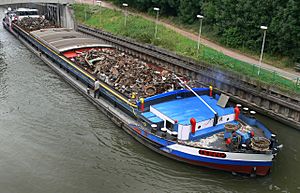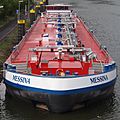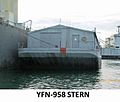Barge facts for kids
A barge is a special type of boat with a flat bottom. Barges are mostly built to carry heavy things like coal, sand, or even large parts of buildings. They usually travel on rivers and canals.
Some barges cannot move by themselves. They need to be pushed or pulled by other boats called towboats. In the past, horses walking on a path next to the water, called a towpath, would also pull barges. A long, thin barge is often called a narrowboat.
Contents
What is a Barge?
Barges are designed to carry a lot of weight. Their flat bottom helps them float in shallow water. This makes them perfect for rivers and canals, which are often not very deep. They are a very old way of moving goods.
How Barges Move
Many barges do not have their own engines. These are called "dumb barges" or "unpowered barges." They rely on other vessels to move them.
- Towboats: These are powerful boats that push or pull barges. They connect to the barge and guide it along the waterway.
- Self-propelled barges: Some modern barges do have their own engines. These can move by themselves, just like regular ships. They are often used for specific types of cargo.
Types of Barges
Barges come in many shapes and sizes, depending on what they carry.
- Hopper barges: These have an open top for carrying loose materials like sand, gravel, or grain.
- Tank barges: These are like floating tanks. They carry liquids such as oil, chemicals, or even water.
- Deck barges: These have a flat, open deck. They are used for carrying large, heavy items that might not fit inside a regular boat. This could be anything from machinery to parts of a bridge.
- Car barges: Some barges are specially made to transport cars across water.
- Royal barges: In some countries, like Thailand, there are special, beautifully decorated barges used for ceremonies. These are not for cargo but for important events.
Why are Barges Important?
Barges play a big role in moving goods around the world. They are often a very efficient way to transport heavy items.
- Cost-effective: Moving goods by barge can be cheaper than using trucks or trains, especially for very heavy loads.
- Environmentally friendly: Barges can carry a lot of cargo using less fuel per ton than other transport methods. This means they can be better for the environment.
- Reduces road traffic: By moving goods on water, barges help reduce the number of large trucks on busy roads.
Barges in History
Barges have been used for thousands of years. Ancient civilizations used simple barges to move building materials and food.
- Early uses: In ancient Egypt, barges were used to transport huge stones for building pyramids.
- Industrial Revolution: During the Industrial Revolution, barges became very important. They moved coal, iron, and other raw materials to factories. Canals were built just for barges to travel on.
- Modern day: Today, barges are still vital for moving bulk goods. They are also used for construction projects on water, like building bridges or dredging rivers.
Images for kids
See also
 In Spanish: Gabarra para niños
In Spanish: Gabarra para niños



























